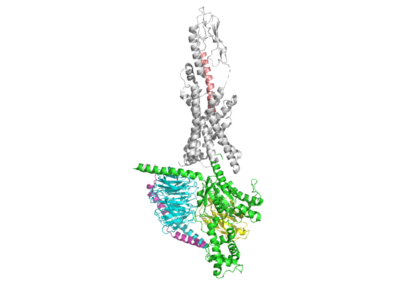User:Preston Roa/Sandbox 1
From Proteopedia
(Difference between revisions)
| Line 6: | Line 6: | ||
[[Image:GLP-1_Bound_to_GLP-1R.png|400 px|right|thumb|Figure 1: GLPR from pymol]] | [[Image:GLP-1_Bound_to_GLP-1R.png|400 px|right|thumb|Figure 1: GLPR from pymol]] | ||
=== History === | === History === | ||
| + | The discovery, clinical development, and characterization of glucagon-like-peptide-1 (GLP-1) encompasses more than 30 years of research from many different scientists/investigators. GLP-1 alongside gastric inhibitory peptide (GIP) are the two primary incretin hormones released by pancreatic beta cells of the intestines following the ingestion of glucose. | ||
=== Function === | === Function === | ||
| + | GLP-1 plays various critical roles in biological processes throughout the body. In adipose tissues, GLP-1 facilitates fat deposition. In bone, GLP-1 inhibits bone absorption. In the brain, both GLP-1 and GIP are involved in memory formation as well as the control of appetite. | ||
| + | Within the pancreas, GLP-1 promotes beta cell proliferation and inhibit apoptosis, allowing for clinically-desirable insulinotropic effects. | ||
| + | GLP-1 exerts its effects by binding to the GLP-1 receptor (GLP-1R) which stimulate effects in the body via G-protein coupled signaling. Receptor binding activates and increases the level of intracellular cyclic monophosphate (cAMP) in pancreatic beta cells as well as glucose-dependent insulin secretion. | ||
| + | |||
=== Relevance === | === Relevance === | ||
| + | Marketed GLP-1R agonists such as dulaglutide, exenatide, liraglutide, and semaglutide represent an expanding drug class with beneficial therapeutic effects for those suffering from type II diabetes and obesity. In more recent years, co-agonist drugs which stimulate both the GLP-1R and GIPR pathways have been synthesized. These co-agonist drugs provide serious promise with regards to assisting those affected by the aforementioned conditions. The co-agonist drug, Tirzepatide, is regarded as one of the most promising candidates for better treatment of obesity and type II diabetes by improving weight reduction and glycemic control. | ||
| + | In this review page, we present the signaling pathways as well as structural highlights within the GLP-1 GPCR pathway in the pancreatic beta cell, focusing on its relevance with regards to the therapeutic effects of the Tirzepatide drug. | ||
== Structure == | == Structure == | ||
=== Extracellular Domain === | === Extracellular Domain === | ||
| + | Broadly the extracellular reactions between GLP-1 and GLP-1R lie between residues 15-32 on the peptide GLP-1. Residues L32, F28, W31 of the peptide and L36 and W214 of the receptor all utilize hydrophobic interactions or van der waals for affinity and binding, but exclusively F28, W31, and W214 have pi stackin which future maximizes interactions to increase binding. Furthermore, there is a strong hydrogen bond between D15 of the peptide to the R380 receptor. Van der Waals interactions continue on the residues Y19, L20, and V16 on the peptide as they interact with L141 and L210 of the receptor. Another hydrogen bond between E27 and Q21 also occurs. Finally, there is a patch of extensive hydrogen bonding in an almost chainlike fashion goin from L32 of the receptor to E21 of the peptide, to R299 of the receptor, to the S17 of the peptide which then interacts with Y205 and T298 both of the receptor. | ||
| + | |||
<scene name='10/1037514/Extracellular_interactions/3'>Extracellular Interactions</scene> | <scene name='10/1037514/Extracellular_interactions/3'>Extracellular Interactions</scene> | ||
<scene name='10/1037514/Extracellular_interactions_2/2'>Extracellular Interactions 2</scene> | <scene name='10/1037514/Extracellular_interactions_2/2'>Extracellular Interactions 2</scene> | ||
| - | <scene name='10/1037514/Extracellular_interactions_3/ | + | <scene name='10/1037514/Extracellular_interactions_3/1'>Extracellular Interactions 3</scene> |
<scene name='10/1037514/Extracellular_interactions_4/1'>Extracellular Interactions 4</scene> | <scene name='10/1037514/Extracellular_interactions_4/1'>Extracellular Interactions 4</scene> | ||
=== Active Site/Binding Site === | === Active Site/Binding Site === | ||
| - | <scene name='10/1037513/Glp_bound_to_glp-1r_h_bonds/ | + | <scene name='10/1037513/Glp_bound_to_glp-1r_h_bonds/4'>GLP-1 bound to GLP-1R H-bonds</scene> |
<scene name='10/1037513/Glp_bound_to_glp-1r_no_clash/2'>GLP-1 bound to GLP-1R: interactions, no steric clash</scene> | <scene name='10/1037513/Glp_bound_to_glp-1r_no_clash/2'>GLP-1 bound to GLP-1R: interactions, no steric clash</scene> | ||
Revision as of 19:44, 23 April 2024
GLP-1
| |||||||||||
References
Student Contributors
- Preston Roa
- Jack Guckien
- Sam Reichenbach

